
Fixed Height Hospital Bed vs Semi Electric Hospital Bed: Buyer's Guide with Full Bundle Included
📋 KEY TAKEAWAYS
| Feature | Fixed Height Beds | Semi-Electric Beds |
|---|---|---|
| Price Range | $800-$1,100 | $1,000-$1,800 |
| Head/Foot Adjustment | Manual crank only | Electric controls |
| Height Adjustment | Fixed (not adjustable) | Manual crank |
| Patient Independence | Limited - requires assistance | Moderate - self-control of positions |
| Caregiver Strain | Higher - all manual adjustments | Reduced - electric head/foot |
| Bundle Value | Basic - lower initial cost | Better - more features for value |
| Medicare Coverage | Limited coverage | Better coverage potential |
Best Overall Value: Costcare Semi-Electric Bed B120C – $1,068 with excellent feature-to-price ratio
Budget Option: Full Electric Medacure 3 Function Homecare Bed – Affordable full bundle package
For Bariatric Needs: Full Electric Bariatric Hospital Bed Costcare B142C – Heavy-duty support
Fixed height hospital bed vs semi electric hospital bed options represent the two most common entry-level choices for home medical care. While both provide essential medical functionality, they differ significantly in features, ease of use, and suitability for various care situations. Understanding these differences is crucial when selecting a complete bed bundle for home healthcare needs.
After thorough analysis of various options available at MedShopDirect's hospital beds collection, the Costcare Semi-Electric Bed B120C emerges as the best overall value option. This semi-electric model combines essential electric features with affordability, making it ideal for most home care situations when purchased as a complete bundle with mattress and rails.
This comprehensive guide will compare fixed height and semi-electric hospital beds across key factors including functionality, cost considerations, patient comfort, and caregiver convenience. We'll also recommend complete bundles that provide the best value for different care scenarios.
Understanding Fixed Height vs Semi-Electric Hospital Beds
Before making a purchasing decision, it's important to understand the fundamental differences between these two hospital bed types.
| Feature | Fixed Height Hospital Beds | Semi-Electric Hospital Beds |
|---|---|---|
| Head/Foot Adjustment | Manual crank only | Electric motors with remote control |
| Height Adjustment | None - fixed at one height | Manual crank |
| Motor System | No motors | Single motor for head/foot positions |
| Power Requirements | None - fully manual | Standard electrical outlet |
| Emergency Backup | Always functional (no power needed) | Manual override for power outages |
Fixed Height Hospital Beds: Basic Design and Functionality
Fixed height hospital beds, as their name suggests, maintain a consistent height that cannot be adjusted. These beds represent the most basic and economical option in the hospital bed market.
Key features of fixed height hospital beds include:
- Manual cranks for head and foot adjustment: Require physical effort to change positions
- Non-adjustable bed height: Typically set at a standard medical height (around 20-24 inches)
- No electrical components: Function without power requirements
- Simpler mechanical design: Fewer moving parts compared to electric models
- Lower initial purchase price: Generally $800-$1,100 for a complete bundle
Fixed height beds are most suitable for situations where:
- Budget constraints are the primary consideration
- The patient doesn't require frequent position changes
- A caregiver is always available to assist with adjustments
- Electrical access is limited or power outages are common
- The standard fixed height works well for both patient transfer and caregiver access
However, these beds have notable limitations:
- Require physical effort for all adjustments
- Can cause caregiver strain with frequent position changes
- Not ideal for patients who need to adjust their own position
- Limited adaptability if patient needs change over time
- Fixed height may not be optimal for all caregiving tasks or transfers
Semi-Electric Hospital Beds: Enhanced Functionality
Semi-electric hospital beds represent a middle ground between fully manual fixed height beds and fully electric models. They offer a balance of convenience and affordability that makes them popular for home care.
Key features of semi-electric hospital beds include:
- Electric motors for head and foot adjustment: Allow effortless position changes via remote control
- Manual crank for height adjustment: Requires physical effort only for occasional height changes
- One-touch position control: Enables patients to adjust their own comfort without assistance
- Standard electrical requirements: Plugs into ordinary household outlets
- Moderate price point: Generally $1,000-$1,800 for a complete bundle
The Costcare Semi-Electric Bed B120C represents an excellent example of this category, providing electric head and foot controls with manual height adjustment at a reasonable $1,068 price point.
Semi-electric beds are well-suited for:
- Patients who need to adjust their own position frequently
- Situations where head/foot adjustments are common but height changes are rare
- Care scenarios with variable levels of assistance
- Homes with reliable electrical service
- Budget-conscious buyers who need essential electric features
Their limitations include:
- Manual effort still required for height adjustments
- Higher initial cost than fixed height models
- Dependence on electricity for head/foot positioning
- Potential need for battery backup during power outages
- Somewhat more complex maintenance than fully manual beds
Cost Analysis and Value Considerations
When selecting a hospital bed bundle, understanding the complete cost picture beyond just the initial purchase price is essential.
| Cost Factor | Fixed Height Beds | Semi-Electric Beds |
|---|---|---|
| Initial Purchase (Bed Only) | $800-$1,100 | $1,000-$1,800 |
| Full Bundle Cost | $1,100-$1,500 | $1,300-$2,200 |
| Operating Costs | None | Minimal electricity |
| Maintenance Costs | Lower - fewer parts | Moderate - motor service |
| Potential Caregiver Costs | Higher - more assistance needed | Lower - less frequent help required |
| Medicare Coverage | More difficult to qualify | Better coverage potential |
Initial Investment and Bundle Components
When comparing complete hospital bed bundles, it's important to consider all components included:
Typical fixed height bed bundle ($1,100-$1,500) includes:
- Basic fixed height bed frame with manual cranks
- Standard foam hospital mattress
- Basic side rails (often half-rails)
- Minimal or no warranty coverage
- Basic delivery (often curbside only)
Typical semi-electric bed bundle ($1,300-$2,200) includes:
- Semi-electric bed frame with electric head/foot adjustments
- Upgraded hospital bed mattress with better pressure distribution
- Full or half-rails with improved design
- 1-2 year warranty coverage
- Better delivery options (often room placement included)
The price difference of approximately $200-$700 between comparable bundles represents the cost of added convenience, independence, and functionality provided by electric controls.
Long-Term Value and Cost Considerations
While fixed height beds have a lower initial price, several factors affect long-term value:
Factors favoring fixed height beds:
- Lower maintenance costs with no electrical components
- No dependency on power supply
- Simpler construction with fewer potential failure points
- Lower replacement part costs if repairs are needed
- No technology obsolescence concerns
Factors favoring semi-electric beds:
- Reduced caregiver strain and potential injury costs
- Increased patient independence potentially reducing care assistance needs
- Better Medicare and insurance coverage potential
- Higher resale value if needs change
- More adaptable to changing patient conditions
For most situations where the bed will be used regularly and long-term, the additional investment in a semi-electric model often provides better overall value despite the higher initial cost.
Medicare Coverage and Insurance Considerations
Medicare coverage can significantly impact the true cost of hospital bed bundles:
Medicare coverage for fixed height beds:
- Covered only in limited circumstances
- Must be documented as medically necessary
- Often requires extensive justification
- May only qualify for rental coverage
- Lower reimbursement rates than other bed types
Medicare coverage for semi-electric beds:
- More readily approved with proper documentation
- Better alignment with medical necessity requirements
- Higher approval rates for purchase vs. rental
- Better coverage of accessories and bundles
- Broader acceptance among Medicare suppliers
For patients with specific medical conditions requiring frequent position changes, semi-electric models more easily meet Medicare criteria, potentially making them less expensive than fixed height beds after insurance coverage.
For specialized needs like bariatric care, bariatric hospital beds with electric functions such as the Full Electric Bariatric Hospital Bed Costcare B142C typically have better coverage potential.
Patient Comfort and Independence
The difference in patient comfort and independence between fixed height and semi-electric beds is substantial and significantly impacts quality of life.
Position Adjustment and Patient Control
Fixed height beds require:
- Physical strength to operate manual cranks
- Assistance for most position adjustments
- Significant effort for frequent adjustments
- Caregiver presence for comfort changes
- Manual cranking that can be slow and difficult
Semi-electric beds provide:
- One-touch electronic controls for head/foot positions
- Independent adjustment by patients with limited strength
- Easy and frequent position changes for optimal comfort
- Smooth, precise positioning adjustments
- Ability to make small comfort adjustments without help
For patients with limited upper body strength, arthritis, or coordination issues, the electric controls of semi-electric beds can be the difference between dependency and independence.
Sleep Quality and Position Variety
Position variety significantly impacts sleep quality and comfort, especially for long-term bed users:
Fixed height beds limitations:
- Less frequent position changes due to effort required
- Fewer incremental adjustments for optimal comfort
- More static sleeping positions leading to pressure points
- Limited ability to find ideal positions for specific conditions
- Difficulty achieving precise angles for medical needs
Semi-electric bed advantages:
- More frequent comfort adjustments throughout the day and night
- Fine-tuning of positions for individual comfort
- Better pressure point management through easy repositioning
- More precise positioning for medical conditions
- Greater position variety reducing discomfort and stiffness
The ability to easily change positions throughout the day and night with semi-electric controls contributes to better sleep quality, reduced pain, and improved overall wellbeing for long-term bed users.
Transfer Safety and Ease
While both bed types have fixed heights, there are distinct differences in transfer dynamics:
Fixed height bed transfer limitations:
- One fixed height may not be ideal for all transfers
- Cannot be adjusted based on patient mobility changes
- May be too high or low for optimal safety
- Transfer boards or additional equipment often required
- Greater risk for both patient and caregiver during transfers
Semi-electric bed transfer considerations:
- Height remains manually adjustable for changing needs
- Can be optimized for specific transfer requirements
- More adaptable to progressive conditions
- Better integration with mobility equipment
- Manual height adjustment still requires effort
It's important to note that while semi-electric beds do feature manual height adjustment, this limitation is less impactful than with fixed models since height adjustments are typically needed less frequently than head or foot positioning changes.
Caregiver Convenience and Support
The choice between fixed height and semi-electric beds significantly impacts caregivers' physical strain, efficiency, and ability to provide care.
| Caregiver Factor | Fixed Height Beds | Semi-Electric Beds |
|---|---|---|
| Physical Strain | High - manual cranking for all adjustments | Reduced - electric head/foot controls |
| Time Requirements | Higher - more assistance needed | Lower - patient can self-adjust |
| Position Changes | Slow, manual process | Quick, one-button adjustment |
| Night Adjustments | Disruptive, requires full activity | Quiet, minimal disruption |
| Care Delivery | More challenging at fixed height | Easier with optimal positioning |
Physical Demands and Ergonomics
The physical demands on caregivers differ significantly between bed types:
Fixed height bed physical demands:
- Manual cranking for all position adjustments
- Considerable upper body strength required
- Repetitive motion stress from frequent cranking
- Risk of back strain from awkward cranking positions
- Greater overall physical demand throughout the day
Semi-electric bed physical benefits:
- Elimination of most cranking requirements
- Reduced risk of repetitive motion injuries
- Lower overall physical exertion
- Less bending and straining for adjustments
- Preserved energy for other essential care tasks
For caregivers with their own physical limitations or who provide care over extended periods, the reduced physical demands of semi-electric beds can prevent burnout and injury.
Time Efficiency and Care Optimization
The time impact of bed type choice extends beyond just position adjustments:
Fixed height bed time factors:
- More time spent on manual adjustments
- Increased frequency of caregiver assistance calls
- Extended time for position-dependent care tasks
- More complex bedding changes with manual positioning
- Greater overall time commitment for basic comfort maintenance
Semi-electric bed efficiency benefits:
- Quick position changes via remote control
- Reduced need for minor adjustment assistance
- Optimized positions for efficient care delivery
- Easier bedding maintenance with powered positioning
- More caregiver time available for quality interaction and care
The cumulative time saved with semi-electric beds can be substantial, particularly in situations requiring frequent position changes or where caregivers are responsible for multiple patients.
Sleep Disruption and Nighttime Care
Nighttime adjustments represent a significant difference in the caregiver experience:
Fixed height bed night challenges:
- Manual cranking disrupts sleep for both patient and caregiver
- Full physical activity required for adjustments
- Lights typically needed for crank operation
- Greater likelihood of avoiding necessary adjustments
- More fully awakening events for both parties
Semi-electric bed night advantages:
- Quiet motor operation for minimal disruption
- Remote operation without leaving bed or chair
- Backlit controls visible without full room lighting
- Quick adjustments for comfort or medical needs
- Reduced full awakening events preserving sleep quality
For caregivers living with patients or providing overnight care, the reduced sleep disruption of semi-electric beds can significantly impact overall caregiver health and wellbeing.
Bundle Options and Recommendations
When purchasing a hospital bed, considering complete bundles that include all necessary components provides the best value and ensures compatibility.
Essential Components of a Complete Hospital Bed Bundle
A complete hospital bed bundle should include:
1. The bed frame itself:
- Fixed height or semi-electric base frame
- All required structural components
- Necessary hardware and assembly parts
- Cranks and/or remote controls
- Warranty documentation
2. Appropriate hospital bed mattress:
- Properly sized for the specific bed frame
- Appropriate firmness and pressure relief
- Waterproof and antimicrobial covering
- Segmented design for proper articulation
- Suitable for the patient's specific needs
3. Side rails and safety accessories:
- Full-length or half-length rails as appropriate
- All mounting hardware and attachment mechanisms
- Safety gaps meeting current standards
- Padding or covers if required
- Easy release mechanisms for emergencies
4. Support items:
- Assembly instructions and user manual
- Maintenance guidelines
- Warranty registration materials
- Contact information for service needs
- Transportation/storage tools if applicable
Best Fixed Height Bed Complete Bundle
For those requiring a fixed height bed, the best complete bundle option is the Full Electric Medacure 3 Function Homecare Bed Bundle, which includes:
- Basic fixed height frame with manual adjustment capability
- Standard foam pressure-relief mattress
- Half-length side rails for safety and mobility support
- All necessary assembly hardware and tools
- 1-year limited warranty on frame components
This bundle represents the best value in the fixed height category, offering essential functionality at an economical price point. While marketed as "full electric," this entry-level model maintains a fixed height with manual adjustments for specific positions.
Best Semi-Electric Bed Complete Bundle
The top recommended semi-electric bundle is the Costcare Semi-Electric Bed B120C Complete Package, which includes:
- Semi-electric frame with powered head/foot adjustment
- Premium foam mattress with enhanced pressure distribution
- Full-length side rails with secure locking mechanisms
- Electric remote control with simple operation
- 1-year comprehensive warranty
- Optional mattress upgrade for specialized care needs
At $1,068, this bundle provides excellent value with the most essential electric functions while maintaining a reasonable price point. The quality of components and warranty coverage make it suitable for long-term use in home care settings.
Best Specialized Care Bundle Options
For specialized care needs, these bundle options offer tailored solutions:
Bariatric care bundle: Full Electric Bariatric Hospital Bed Costcare B142C Package
- Heavy-duty bariatric frame with 600 lb capacity
- Reinforced bariatric mattress with enhanced support
- Extra-wide design for comfort and prevention
- Bariatric-rated side rails and supports
- Specialized warranty for heavy-duty use
For bariatric hospital beds with expanded width options, the Costcare Bariatric Adjustable Hospital Bed B359 provides width flexibility between 54"-60" at $3,457.
Full-featured premium bundle: Icare Adjustable Electric Home Hospital Bed IC333 Package
- Fully electric operation including height adjustment
- Premium pressure-relief mattress system
- Residential-style headboard and footboard
- Designer side rails with safety features
- Extended warranty and service package
- Home-friendly appearance with medical functionality
Frequently Asked Questions
Does Medicare cover fixed height and semi-electric hospital beds?
Medicare covers both types when medically necessary, but semi-electric beds qualify more easily with proper documentation.
How much physical strength is needed to operate a fixed height bed?
Moderate upper body strength is required for manual cranking, which may be difficult for elderly caregivers or those with arthritis.
Can I upgrade a fixed height bed to semi-electric later?
No, the frame designs are fundamentally different and cannot be converted after purchase.
Which type requires less maintenance over time?
Fixed height beds require less maintenance with no electrical components to service or replace.
Are side rails included in most hospital bed bundles?
Most bundles include at least half-rails; always verify specific rail type and coverage included in your package.
Which type is better for elderly patients who spend most of the day in bed?
Semi-electric beds are strongly recommended for bedridden patients due to easier position changes and improved independence.
What's the typical lifespan difference between these bed types?
Both types typically last 7-10 years with proper maintenance; electric components may require service after 5-7 years.












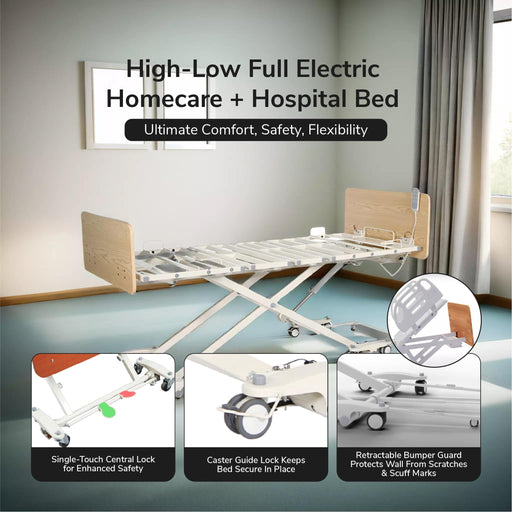
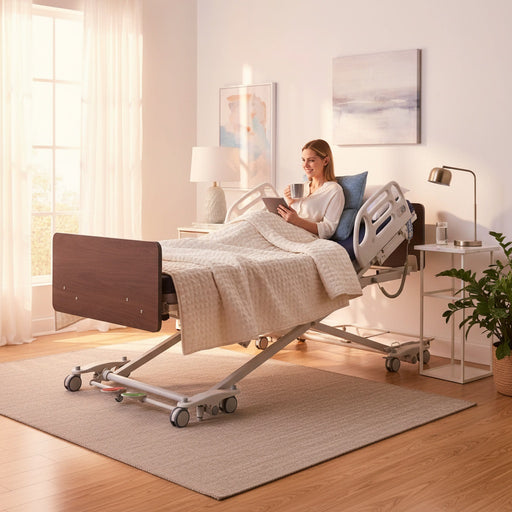
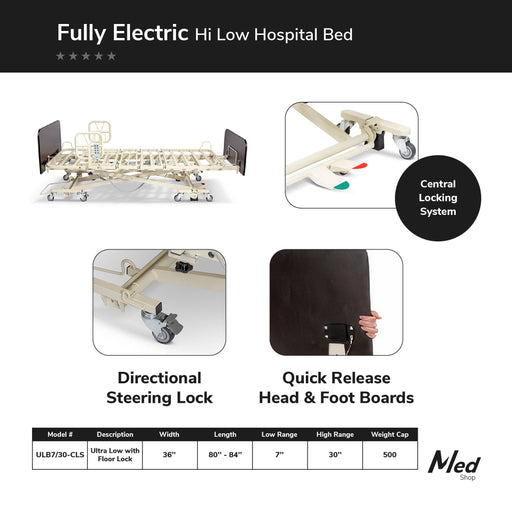
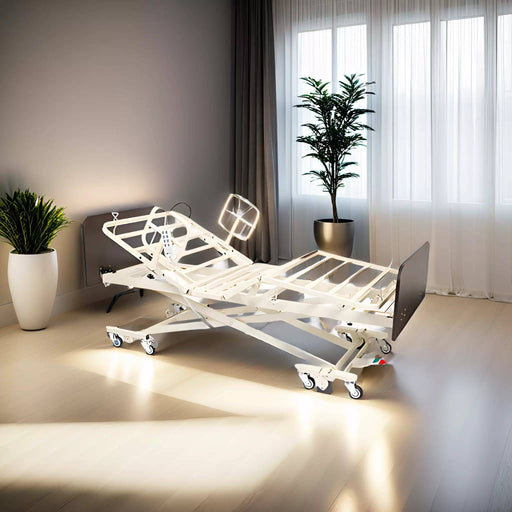


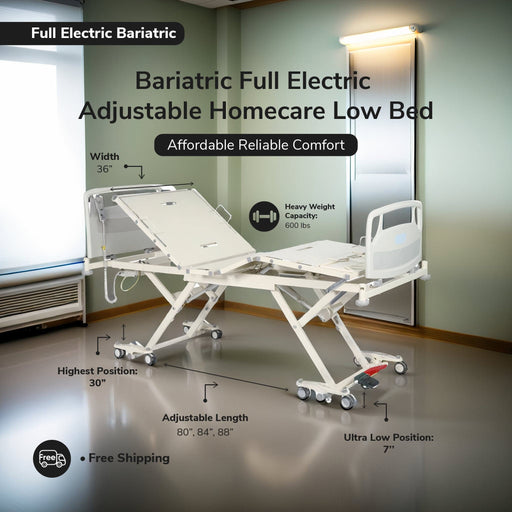
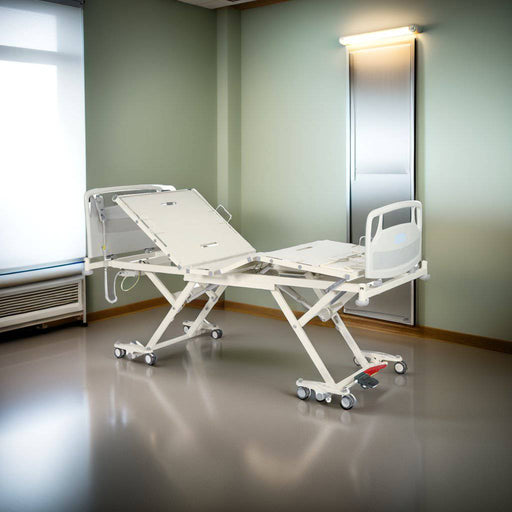
Leave a comment